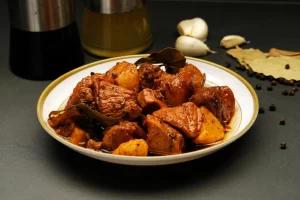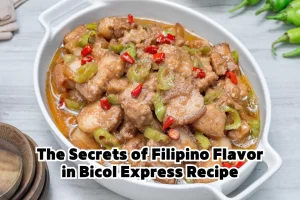The Best Fluffy Pancakes recipe you will fall in love with. Full of tips and tricks to help you make the best pancakes.
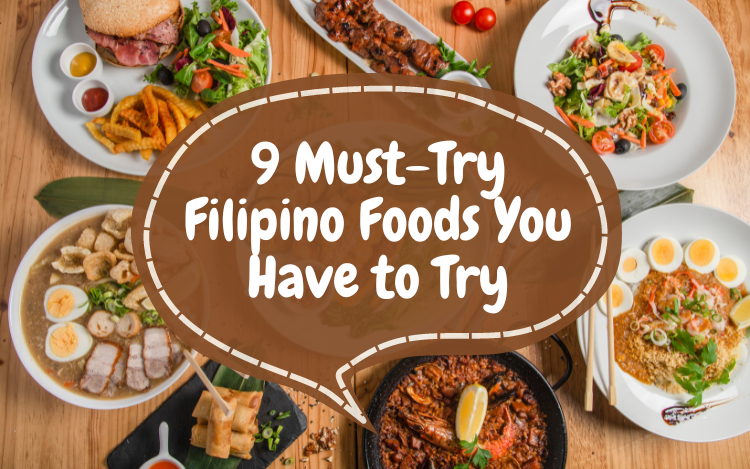
While exploring the Philippines, these are the must-try dishes you won’t want to miss. You’ll encounter most of these delicacies across the country, although regional variations may exist due to the diverse array of ingredients found in different regions.
Filipino cuisine, with its subtle influences from neighboring Asian countries, stands out as one of the most unique in the world. This distinctiveness can be attributed to the Philippines’ island geography, which sets it apart from continental Asia. From traditional chicken stew to duck embryos and everything in between, FoodyDate invites you on a culinary journey through the Philippines, where you can indulge in delicious and adventurous flavors.
1. Purple Yam (Ube)
Purple Yam, also known as “Ube” in Tagalog, is a vibrant tuber native to the Philippines, renowned for its sweet and mellow taste. In contrast to its orange cousin, Purple Yam offers a delightful blend of nutty and vanilla flavors, making it a popular ingredient in Filipino desserts. At FoodyDate, we recognize the nutritional value of Purple Yam, rich in healthy carbohydrates, vitamins, and fiber. Notably, the purple variety of Purple Yam contains elevated levels of antioxidants, contributing to overall health and well-being. It is important to consume Purple Yam-infused treats in moderation, as desserts may contain added sugars and fats.

2. Adobo
Adobo, a beloved Filipino classic, features tender pork or chicken marinated and simmered in a flavorful blend of vinegar, soy sauce, garlic, bay leaf, and black peppercorns. At FoodyDate, we recognize adobo as a staple dish in Filipino households, often enjoyed with a steaming hot cup of rice.
To enhance regional flavors, each family adds its own twist to Adobo, such as coconut milk or turmeric. Some people choose chicken over pork, resulting in succulent and flavorful meat. Filipino cuisine is often associated with adobo, which is no surprise.
Foreigners, too, often fondly recall and appreciate the savory delights of pork or chicken adobo when reminiscing about their culinary experiences in the Philippines.In reminiscing about their culinary experiences in the Philippines, foreigners often recall and appreciate the savory delights of pork or chicken Adobo.
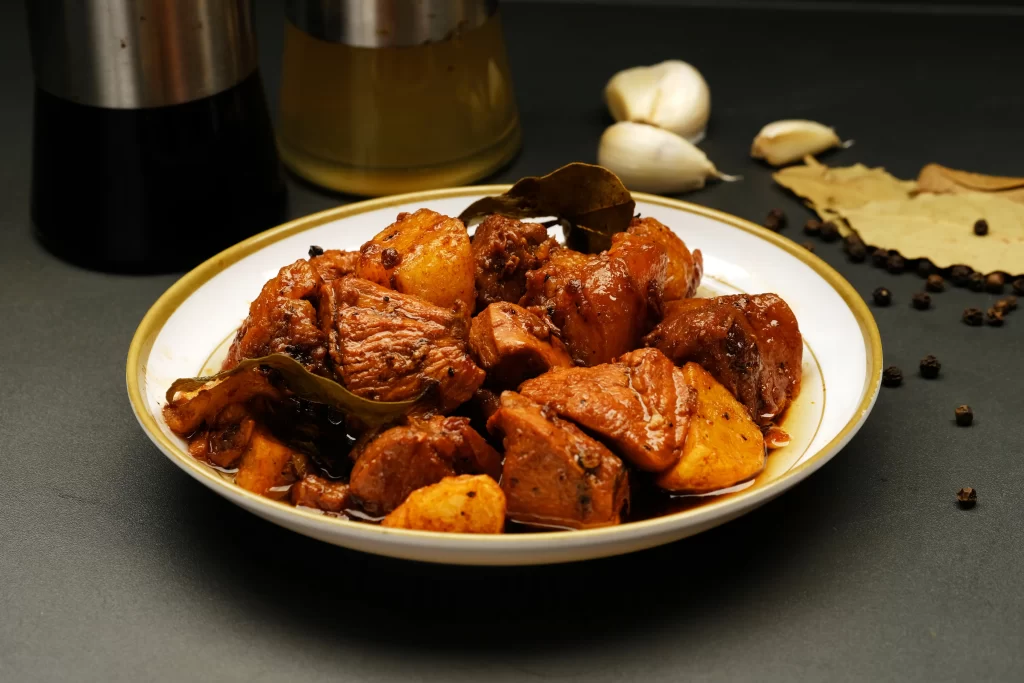
3. Sinigang
Filipinos love Sinigang, a comforting soup perfect for accompanying grilled meats or seafood. Sinigang is one of FoodyDate’s favorite dishes for balancing flavors during a hearty meal.
Typically made with pork as the main protein, Sinigang features an array of vegetables such as radish, taro, eggplant, string beans, tomato, and onion. However, beef, shrimp, fish, or chicken can be used as alternatives to pork. Tamarind is the traditional souring agent, though some variations incorporate guava, santol, tomato, or kamias for a unique twist.
The sour soup is sure to tantalize taste buds, whether it’s a traditional pork Sinigang or a seafood rendition.
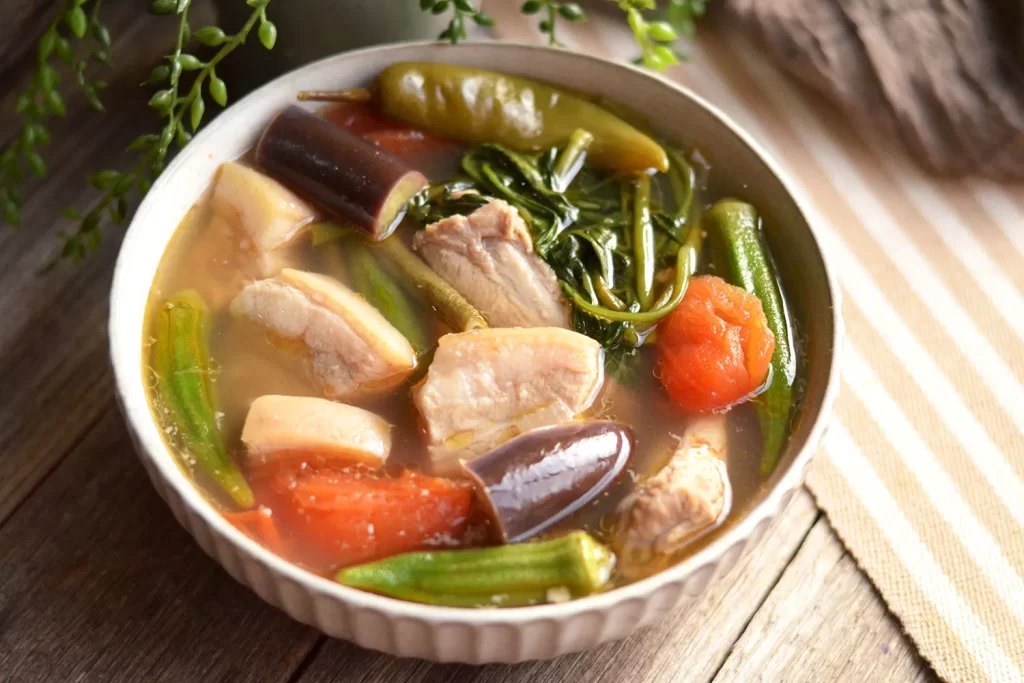
4. Lechon
Every town fiesta and major celebration in Filipino homes is marked by Lechon, a spit-roasted pig. A lechon’s charm comes from its meticulous preparation, which involves stuffing the pig with aromatic herbs like lemongrass, onions, and garlic, then slowly roasting it over charcoal until its skin turns a delectable reddish brown.
Locals and foreigners alike have been captivated by the irresistible combination of crispy skin and tender meat. Indulging in its succulent flavors, renowned chef Anthony Bourdain called it “the best pig ever!”. Despite Manila and Cebu’s reputation as hotspots for Lechon, this beloved dish is available throughout the Philippines, each region adding its own unique twist by varying stuffing, roasting style, duration, and choice of pig. Explore the rich flavors of this iconic Filipino dish with FoodyDate, whether you’re craving the classic Lechon experience or seeking out innovative renditions.
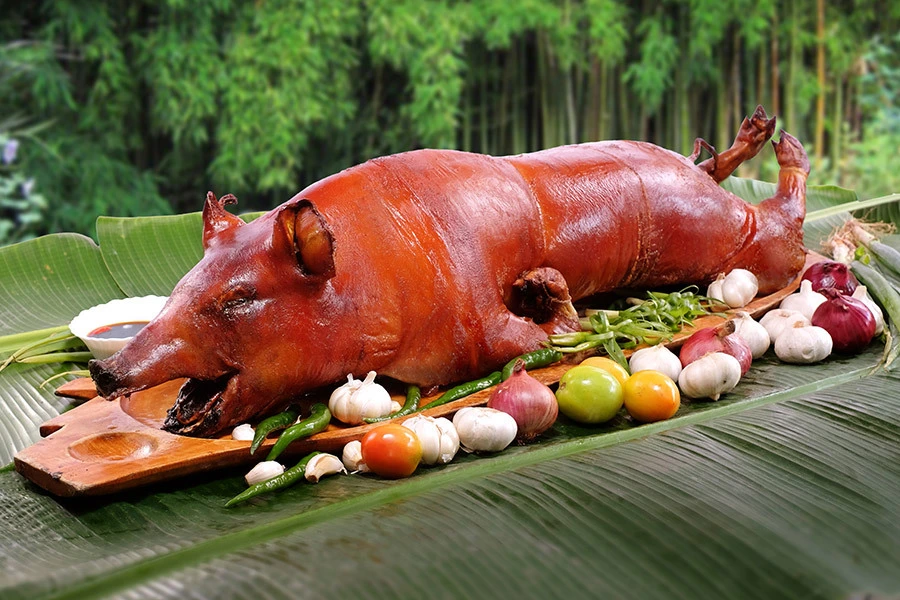
5. Balut
FoodyDate invites you to experience one of the Philippines’ most intriguing delicacies: Balut. In essence, this exotic treat is a boiled egg containing a semi-developed duck embryo aged 16 to 21 days. You won’t be disappointed with the taste, even though it sounds strange to some.
There is a sensory component as well as a culinary component to eating balut. Let the flavors take precedence over its appearance. To enjoy Balut, start by cracking a hole in the rounded end, savoring the flavorful juice inside. Enhance the taste with a dash of salt or vinegar before consuming the contents, excluding the hard, white portion. The broth boasts a rich, gamey flavor reminiscent of chicken soup, while the yolk offers a creamy texture akin to a traditional boiled egg. You should try Balut during your culinary journey in the Philippines, despite its intimidating appearance.

6. Pancit
Pancit, a beloved Filipino dish, encompasses a variety of noodle-based recipes, each offering a unique blend of flavors. Here at FoodyDate, we celebrate the diversity of pancit, a dish that typically consists of rice noodles, vegetables, and often meat such as pork or chicken.
To create your own homemade pancit, follow these simple steps:
- Begin by softening the rice noodles.
- Cook onions and garlic in oil until aromatic, then add the remaining ingredients.
- Cook until the vegetables are tender, then mix in the softened noodles.
- Garnish with lemon wedges for a refreshing touch.
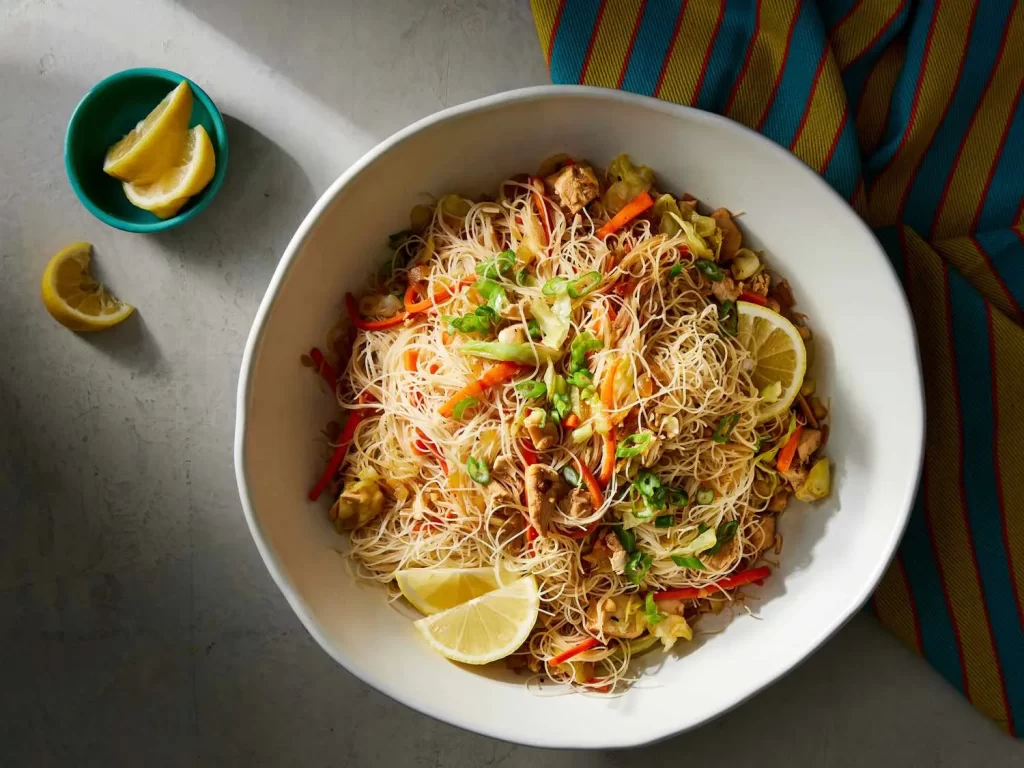
7. Lumpia
With FoodyDate, you can make restaurant-quality Lumpia right in your own kitchen! This traditional Filipino recipe yields perfectly crispy and absolutely irresistible spring rolls every time.
Lumpia, fried spring rolls found in Filipino and Indonesian cuisines, feature a thin pastry skin, also known as a lumpia wrapper, and are typically stuffed with a savory mixture of ground pork and vegetables. Serve these delightful Lumpia as a side dish or appetizer alongside a sweet chili dipping sauce for an unforgettable culinary experience.

8. Tinolang Manok
With every sip of its flavorful broth, Tinolang Manok evokes a sense of home for many Filipinos, making it the epitome of comfort food. This classic chicken stew, simmered with green papaya, chili leaves, onion, ginger, and fish sauce, is a cherished culinary tradition. Some variations include the addition of malunggay or moringa leaves, known for their nutritional benefits. However, the true essence of Tinolang Manok lies in using native chicken, imparting a rich and authentic taste.
Tinolang Manok is a staple in Filipino households, especially in the provinces, where locals can easily catch a chicken from their backyard and harvest fresh papaya and chili leaves. It’s a simple yet satisfying meal enjoyed for lunch or dinner, offering a taste of genuine Filipino home cooking.
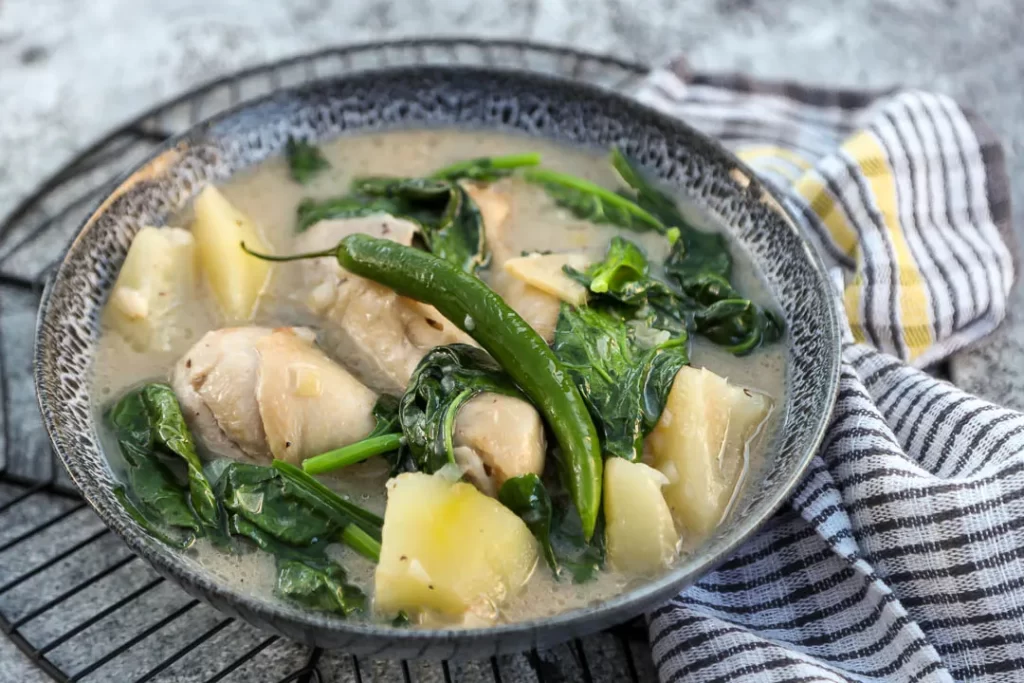
9. Bicol Express
At FoodyDate, we’re all about embracing the bold and vibrant flavors of spicy cuisine, and Bicol Express perfectly embodies this culinary adventure. This sizzling pork stew, infused with creamy coconut milk, savory shrimp paste, and a generous kick of chili peppers, promises an unforgettable taste experience. Taking its name from a historic train journey from Manila to Bicol, it hails from the Bicol region. Explore the fiery depths of Bicol Express, a dish that promises to tantalize your taste buds.
The tender meat, bathed in a creamy yet spicy soup, is a delight for adventurous palates. Our taste buds can’t get enough of Bicol Express‘ bold flavors, even though those with a low tolerance for spicy food may be hesitant.
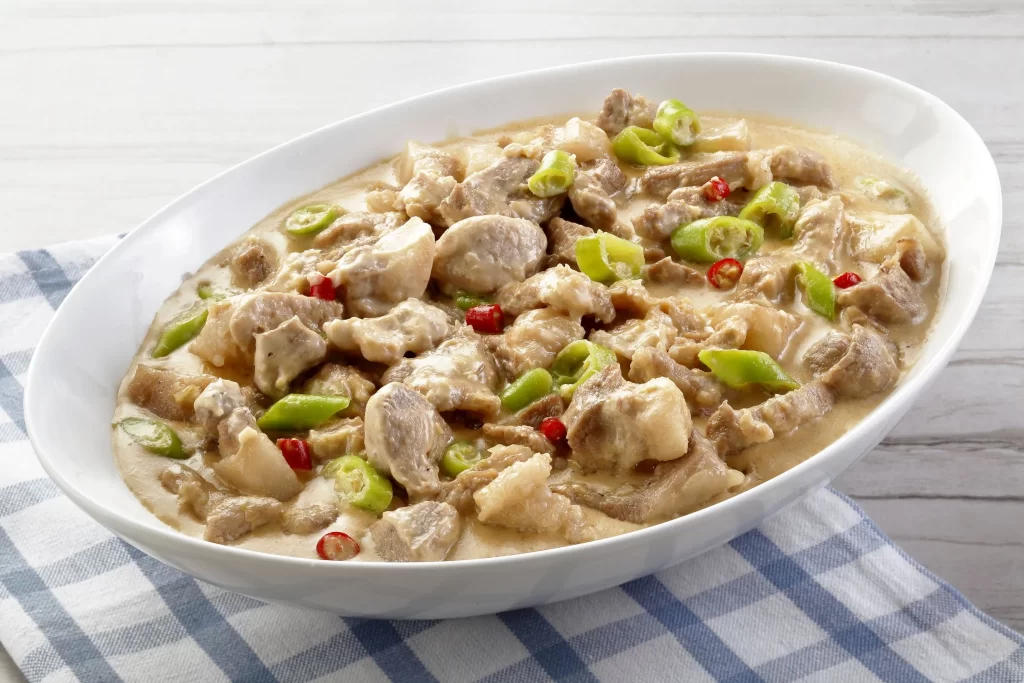
Conclusion
A captivating blend of diverse flavors characterizes Filipino cuisine, which reflects the country’s rich cultural heritage. From Purple Yam to Adobo, Sinigang, and Lechon, each dish tells a unique culinary story. Whether you’re adventurous enough to try Balut or prefer the comforting warmth of Tinolang Manok, there’s something for everyone to enjoy. Embark on a culinary journey with FoodyDate and discover the must-try Filipino foods that will tantalize your taste buds. Join us in celebrating the delicious diversity of Filipino cuisine and let FoodyDate be your guide to exploring the flavors of the Philippines.
FAQ.
Q. What is the significance of food in Filipino culture?
Throughout Filipino culture, food serves as a means of celebration and bonding among families and communities. There is a strong emphasis on hospitality and sharing in many Filipino traditions and gatherings.
Q. Are Filipino dishes spicy?
However, not all Filipino dishes are spicy. The level of spice varies by region and individual preference. Sinigang and Tinolang Manok have a milder flavor profile than Bicol Express and some versions of adobo.
Q. Can I adjust the level of spiciness in Filipino dishes?
You can spice up Filipino dishes. Chili peppers or spicy condiments can be used to control the heat level. Depending on how spicy a person likes their food, spicy condiments can be served on the side.


